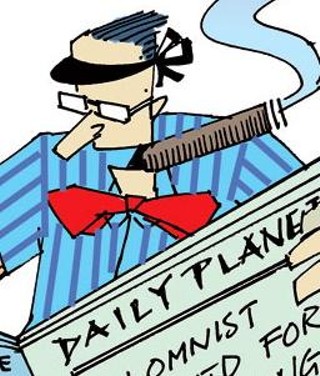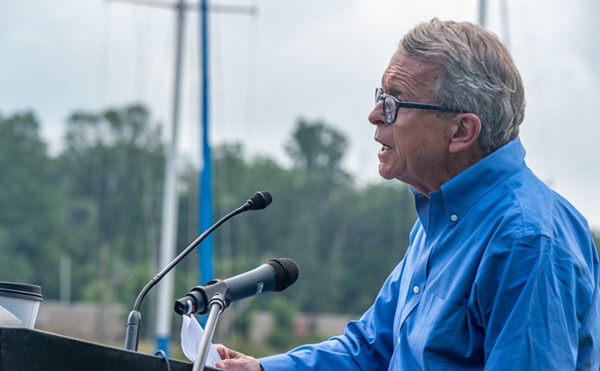When the former B.F. Goodrich leader joined Oglebay in late 1997, he refused to accept a salary. At the time, Lauer was a doctoral candidate at Case Western Reserve University, and his thesis was on one of the hot-button issues of the day: executive pay -- and the excesses thereof. So in a commendable display of practicing what one preaches, Lauer opted for performance-based bonuses and stocks in lieu of a paycheck. He also purchased $1 million in company stock. Lauer was taking a multi-million-dollar gamble on himself.
"When we put the deal together," Lauer told the Associated Press in 1998, "the way we designed it was that I wouldn't get credit for market momentum. I'd get credit for true growth."
And growth is what Oglebay got. Traditionally focused on ore mining and shipping, Oglebay would leave ore and the fading steel industry behind in favor of lime, limestone, and sand. Surveyor, a publication of the American Bureau of Shipping, summed up the transition in 2001: "What began as an ore company that also had boats, and became a steamship company that also had minerals, is now a stone company that also has boats."
Revenues soared, and Oglebay rose steadily up the Weatherhead 100, Case's annual ranking of Northeast Ohio's fastest-growing businesses, going from 20th in 1999 to 4th in 2002. The value of Oglebay shares -- long an unexciting but reliable "widows and orphans stock," as one longtime holder puts it -- reached previously unimaginable heights. Lauer's vision of building the sleepy, narrowly focused company into a billion-dollar behemoth actually seemed plausible. And through it all, his reputation soared. He was featured in numerous national publications and hailed as a new breed of leader in a best-selling management book. The AFL-CIO declared him a "CEO pay hero."
But his plan was built on the New Economy, which meant rapid expansion and equally frantic borrowing -- in this case, hundreds of millions of dollars. Yet as the New Economy began to look hopelessly naive, so did Lauer's plans for Oglebay. It was one thing to assume the stock market would rise forever, as many business leaders did. It was quite another to believe, as Lauer apparently did, that the company would integrate its new operations quickly, and that rapid growth would allow rapid repayment of debt. He was wrong. The debt began to weigh down the company like flooding in a ship's hull. Last February, Oglebay Norton -- once "the most conservative, risk-averse company that ever existed," according to one analyst -- filed for bankruptcy.
Oglebay management predicts that a stronger company will emerge. But it's in their interests to focus on the future. Shareholders, who have watched the stock price dwindle from a high of $50 to mere pennies, still have questions about the past. Most pertain to Lauer, and what, if anything, the board of directors did to make sure investors' interests were protected.
Of course, many of these same shareholders weren't so curious about the inner workings when their stock was ascending. But they note that the company, founded in the mid-19th century, had already survived depression, countless market swings, wars, and technological revolutions. In just a few heady years under Lauer, it collapsed. Even in the Rust Belt, its disintegration stands out.
"They took a magnificent company, one of the bedrock companies of Northeast Ohio's economy, and they ruined it," says shareholder Douglas Barr.
The company that would become Oglebay Norton was established in 1851 and quickly moved into the growing iron-ore market. In 1855, it employed then-unknown John D. Rockefeller as a bookkeeper at $3.50 a week. "The three and a half years of business training I had in that commission house formed a large part of the foundation of my business career," he wrote years later. In the 1890s, Oglebay, Norton and Company acted as the sales and shipping agent for Rockefeller's Lake Superior Consolidated Iron Mines.
Rockefeller sold his mines and ships to United States Steel in 1901, but Oglebay carried on, managing mines and buying and building ships to haul raw materials over the Great Lakes. Decades of high demand for steel -- fueled by the rise of the automobile and two world wars -- kept the company busy, as did forays into coal and taconite. In 1957, it absorbed some of its affiliates, adopted the name Oglebay Norton Company, and began trading publicly.
Oglebay's last brush with unwanted attention came with the sinking of the Edmund Fitzgerald amid freakishly bad weather on Lake Superior in 1975. Oglebay operated the ship for owner Northwestern Mutual Life Insurance Company. All 29 crew members died.
In the early 1990s, Oglebay began moving away from industries like coal and iron ore. Today, the company mines and processes lime and limestone for the construction, environmental, and metallurgical industries, in addition to sands and specialty minerals used in everything from paint to oil-drilling operations. The company also owns and operates a 12-ship Great Lakes fleet, which in 1996 hauled 22 million tons.
Come the late '90s, however, the board had grown restless, according to several sources. Exactly how and when John Lauer came into the picture isn't clear; neither he nor any current board members responded to interview requests. But by late 1997, R. Thomas Green, who'd been president and CEO since 1992, was out, and Lauer was in.
"He had an excellent reputation," says Harry Millis, a retired analyst who followed both Oglebay and the tire industry, in which Lauer had previously worked as president of B.F. Goodrich.
There was some speculation that Lauer left Goodrich because he wasn't aggressive enough for the company's board, Millis says. Lauer's own accounts don't shed much light. A 1998 Fortune profile said he left "in hope of becoming a CEO elsewhere or launching his own company." But a 2002 Harvard Business Review article said the "inspirational leader" had "lost his spark" after six years of meetings and memos: "Over time, Lauer had fallen in step with a corporate culture that was focused on shareholder value in a way that was inconsistent with what he cared about. Not surprisingly, he left the company six months later, breaking from corporate life by joining his wife with her work with Hungarian relief organizations."
An extended timeout ensued, during which he "wanted nothing to do with running a company," the article said. Instead he pursued an executive doctorate at Case. He was wrapping up his dissertation -- on how multimillion-dollar CEO salaries hurt employee morale and productivity -- when Oglebay came calling.
The board loved his revolutionary notion of being paid only for performance. "It generates instant respect," said director James Bartlett in a 1998 Fortune article. "The word was out that we had a leader who was willing to put himself on the line, and that this will be a damn interesting place to work."
And it was. Armed with a mandate for change, Lauer set to work realizing his vision of dramatic expansion -- the kind that would attract attention from big-time investors. Oglebay bought small competitor Colorado Silica, an industrial sands company. Then it entered the lime and limestone market by acquiring three companies, including Global Stone Corporation, the fifth-largest lime and limestone producer in North America, for $226 million. The combination of these acquisitions immediately constituted Oglebay's largest division.
But by June '98, the company's debt had risen from $45 million the previous year to more than $300 million. At the annual shareholders' meeting the following month, Lauer laid out his plan for further expansion and the achievement of $1 billion in revenues -- up from $145 million in '97 -- by 2000. He was elected chairman of the board.
A year later Oglebay bought another company's mineral assets and created Oglebay Norton Specialty Mineral. The spending binge continued throughout 2000. Michigan Limestone Operations in April. Jebco Abrasives of Texas in June. A property of J.M. Huber Limestone of Indiana in September. All for cash.
"He'd buy almost anything," recalls Brent Baird, a former board member from Buffalo, still sounding incredulous years later. "And it was all with borrowed money."
Baird, who'd joined the board around 1990 after buying more than 500,000 shares, says he supported "the first one or two" acquisitions, but started asking questions as the frenzy continued -- and the debt mounted. "When I was first with the company, we didn't have a lot of debt," he explains. "I'm a conservative guy; I don't like to pay money to banks."
The first time Baird raised these concerns, Lauer talked about growth and diversification, and most board members -- "the Cleveland old boys' network," as Baird puts it -- seemed content. The next time Baird asked questions, Lauer got "nasty." A heated exchange ensued.
"Lauer would do that if you challenged him," says John Weil, a former board member and shareholder from St. Louis, who also grew skeptical over time. He recalls Lauer's response to Baird: "Why'd you hire me if you wanted me to be a custodial manager?"
Driving home after that meeting, Baird thought, "This is nuts. I'm gonna quit." Once the second-largest stockholder, he opted not to stand for reelection to the board and began selling his shares as soon as the law allowed. Weil, who owned about 600,000 shares, became the sole vocal dissenter on the board.
At a meeting in St. Louis shortly after the Michigan Limestone deal, Weil says, Lauer talked about pushing earnings to heights unheard of at the long-sleepy company. Only later did Weil learn that Lauer's earnings projections hadn't taken into account routine off-season maintenance at Michigan Limestone or that the economy was showing signs of softening. "I began worrying that the board wasn't getting the full story," he says.
Others wonder whether most board members even wanted the full story.
Lauer's moves made sense at the time, says Millis, the analyst who followed Oglebay. "I don't think anyone questioned the strategy or the individual acquisitions at the time they were done," he says. Indeed, Wall Street "applauded," with rising stock prices. In June 2000, BB&T Capital Markets strongly advised its clients to buy Oglebay stock, calling it "compellingly" undervalued.
"Oglebay has achieved strong competitive positions with these acquisitions . . . The transition at Oglebay is likely the cause of some skepticism and uncertainty among investors . . . [The] transition has put the company in two seemingly distinct lines of business, shipping and minerals . . . The increased degree of leverage does raise Oglebay's risk profile . . . If the company achieves goals, then it will have compounded earnings at an annual rate of 15 percent."
In other words, the company was poised for tremendous growth . . . or an ugly fall. And that's when forces began to turn against it.
In 2000 and 2001, the water levels in the Great Lakes dropped to their lowest in decades, limiting the amount of tonnage Oglebay's ships could carry without running aground. At the same time, fuel costs rose, further eating into profits. Lauer remained optimistic, however, predicting revenue of $425 million to $440 million for 2001, up from 2000's $393 million.
Lauer's strategy was to acquire companies within or closely related to Oglebay's expertise and run them more efficiently as a group than they could operate freestanding. "Like Ford buying GM and Chrysler," says Scott Thompson, a director at financial crisis-management adviser Alvarez and Marsal in New York. A Ford-GM-Chrysler megacorporation merger would have one headquarters, not three; one human-resources department, not three, and so forth. The key is to take advantage of all the cost savings. (Thompson held Oglebay stocks left to him by his grandfather, who was the company's lawyer for many years.)
But there were flaws in the plan. First, Oglebay paid peak prices, because the economy was strong and mergers and acquisitions were occurring everywhere; many companies were overvalued in the late '90s, Thompson notes.
Still, the seemingly boundless economic growth at the time made the risk appear manageable. "You see that a lot with these smaller companies," says Dominick D'Ascoli, an analyst with Standard & Poor who followed Oglebay. "They miscalculate the market going forward." And when the economy goes south, the debt becomes more of a burden than they're prepared to carry.
The first half of 2001 was rough. In July, Oglebay was forced to admit that earnings for the year would be well below those of 2000. In September, it warned that business would not improve until the economy recovered. And in October, Oglebay stopped paying dividends to shareholders, sending the stock price into free fall.
The following month, Lauer lost one of his titles. Michael Lundin, who'd come to Oglebay in the Michigan Limestone deal, was named president. It was the start of a tumultuous year and a half.
Early in 2002, Oglebay acquired yet another company -- Erie Sand & Gravel. A few months later, Oglebay announced that Lundin would succeed Lauer as CEO at the end of the year. Lauer would remain chairman of the board. Before that happened, however, the company secured $75 million in financing at a whopping 18 percent interest. Awash in debt, management was playing for time.
By the April 2003 annual meeting, shareholders were restless. Days before, Thompson shared with Douglas Barr, a shareholder with old family ties to the company, the results of an informal analysis he'd done: "As I calculate . . . all cash flow from operations over the next two years (at a very minimum) will go to pay interest and cover necessary capital expenditures, with nothing left over to reduce debt," he wrote. By 2004, he predicted, the company could have paid well over $60 million in interest.
He offered suggestions drawn from his experience with struggling companies, but noted: "I don't expect my ideas to be popular with management or the board, as [they] would require an attitude change from grandeur to restructuring and could be viewed as an admission of failure."
At the meeting, Lundin was asked if he'd consulted bankruptcy attorneys. He said no. But Lundin later admitted that he had spoken to lawyers about a bankruptcy filing, says Barr.
The real intrigue involved Lauer. Two hours after being reelected chairman of the board, he resigned. Board member Al Bersticker, who'd met privately with Lauer before the surprise announcement (and who became the next chairman), would not explain what happened. "We thank John for his service, dedication, and leadership at Oglebay Norton," he said in a statement, "and we wish him well in his future endeavors."
In May 2003, Geoffrey Seymour, a trustee for nearly 150,000 shares of Oglebay stock, wrote to Bersticker, seeking explanation for "the substantial and unacceptable loss of value of this holding." He itemized a list of questions, but the first one got right to the heart of the matter: "Specifically, how did you act to safeguard shareholder value in approving this debt increase?"
Seymour says that Bersticker called to say he was aware of the board's responsibilities. But he wouldn't say how it had filled them, nor did he address any other concerns.
Seymour's experience wasn't unique.
As the company's distress became obvious, the board increasingly hid from shareholders and the media. There was no annual meeting this year. And when Douglas Barr, whose wife is a descendant of earlier Oglebay executives, sent identical letters to all board members last October, asking many pointed questions, the only response came from Lundin. "[T]he board has created a formal policy stating that the president and CEO is responsible for all public disclosure and communication," he wrote. But Lundin didn't answer most of Barr's questions, claiming that Barr was "not seeking factual information, but rather opinion and in some instances speculative analysis."
The board's silence only encouraged shareholders to blame them for Oglebay's state.
"As near as I can tell, they did nothing to rein [Lauer] in," Barr says. To him and many other shareholders, the board's stewardship was, at best, unconscionably shortsighted. That board members have refused to buy stock in the company in recent years, despite being urged to by Barr and others, compounds their frustration. (Barr says that one member bluntly stated that it was a bad investment. Another begged off by claiming a shortage of cash: "Doug, I'm building a very expensive house in Phoenix.")
"I've got a general picture, which is pretty abominable," says Robert Crawford of St. Louis, who's owned a few thousand shares for two decades. In 50 years of investing, he says, "I've never seen anything like this before."
"It was a good, solid company, and it was like a family almost," says Thomas Thompson, a Columbus attorney. "It's sad to see a business with that much tradition die as it did."
The business has not died, but for longtime shareholders, it might as well have. From decades of no-frills stability to the once-unimaginable stock price of $50 per share to the equally incomprehensible bankruptcy and a NASDAQ delisting just a few short years later, it's been like watching the quick demise of a beloved relative.
Shareholders have formed an informal network and support group, scrutinizing new developments and piecing together unconfirmed bits and pieces. One rumor bouncing between them in the spring turned out to be true: There have been offers to buy Oglebay's assets. In March, a group led by Lafarge North America, the continent's largest supplier of construction materials, informed Oglebay's bankruptcy lawyer of its interest. Nathan Creech, Lafarge's director of business development, declined comment.
Two of those prospective buyers resurfaced later in another consortium. In July, Cleveland attorney Thomas Coffey confirmed that a group including two names well-known at Oglebay -- R. Thomas Green, who was replaced by Lauer, and Renold Thompson Jr., son of the CEO who preceded Green -- made an offer of $451 million. This consortium would break up the company, but operations currently based in Cleveland would stay. (Renold Thompson -- no relation to Thomas and Scott -- did not respond to interview requests. Green "regretfully" declined to comment, citing ongoing talks.)
To shareholders, $451 million sounds like a good deal -- certainly better than what Oglebay's plan offers them: first crack at a limited number of new shares when the company emerges from bankruptcy. Oglebay Vice President and General Counsel Rochelle Walk calls this a "gift": Typically, in bankruptcies like this one, shareholders get nothing.
This too they might see as a gift, though one of little value: The board of directors will be replaced.
To Michael Lundin, Lauer's hand-picked successor, falls the unenviable task of righting the ship.
No one wanted to file for bankruptcy, says Michael Lundin in an interview in his North Point Tower office. But by late 2003, it was becoming increasingly clear that a Chapter 11 reorganization was "the most viable option to sustain the company going forward."
After Oglebay was forced to seek new terms for debt repayment, its bankers demanded a $100 million reduction in debt by February 2004. The company hired a financial adviser to explore selling some assets, such as the mica and lime operations, but the offers were insufficient. (The mica asset remains on the market.) Oglebay eventually sold a lawn-and-garden-products business, but this barely put a dent in the debt.
"We reached out to the marketplace to get their input," says Lundin, referring to the shopping of some assets. "And it was only after that process that we concluded that we needed to file for [bankruptcy] protection."
But that process, he adds, has offered a validation of sorts. The company entered bankruptcy with a new $75 million credit package, then secured another $305 million to pay off its former bank group and reemerge from Chapter 11. "We have good core businesses," Lundin says, "and the market has recognized that and is validating that."
Despite formal objections from some shareholders and the Green-Thompson consortium -- both parties complained that Oglebay was disclosing far less about its assets and liabilities than bankruptcy law requires -- the company's plan was largely approved by a bankruptcy judge in July. Lundin says the company has met with the consortium of prospective buyers and takes the offer seriously, but "We have a plan, and we are committed to that plan." Last week, company spokesman Patrick Gallagher confirmed that talks with the consortium were ongoing, but that a deal remained unlikely. A final hearing on Oglebay's reorganization plan is scheduled for September 29.
And after that? "We're going to be more focused" on the core businesses, specifically limestone. He is careful not to sound disparaging of decisions made on Lauer's watch, but admits the current plan is "clearly a different strategy."
"I'm an engineer, and engineers tend to look at things in a very quantitative way, but the world doesn't really operate like that," John Lauer said in a 2002 interview with Human Resource Executive magazine. "There's a lot of change and ambiguity."
The article goes on to describe Lauer's experiences with "emotional intelligence," a psychologically influenced take on management that emphasizes careful self-assessment, better listening skills, and delegation. Richard Boyatzis, a Case professor and co-author of the book Primal Leadership: Realizing the Power of Emotional Intelligence, helped Lauer organize Oglebay's management through "a series of customized courses that included case studies from the company, courses in EI taught by Boyatzis, and in-depth self-assessments by each manager -- with the assistance of a coach -- of their own leadership styles and goals," the story noted.
Yet it failed to mention that, by the time it was published, Lauer had already stepped down as president, and Oglebay was hurtling toward bankruptcy.
Today, shareholders can take some satisfaction from knowing that Lauer will lose his $9,000-per-month retirement payment as part of the company's reorganization. He would have had to live a long time to make the millions he could have demanded in traditional salary and bonuses, anyway. But perhaps that's a small price to pay for taking a venerable company down with him.
"He looked like a great guy," says former board member Weil. "He just seemed not to understand leverage."














